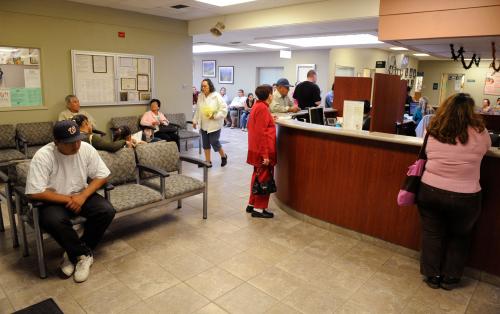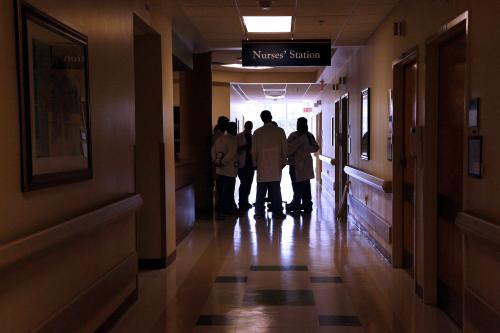What’s the latest in health policy research? The Essential Scan, produced by the USC-Brookings Schaeffer Initiative for Health Policy, aims to help keep you informed on the latest research and what it means for policymakers. If you’d like to receive the biweekly Essential Scan by email, you can sign up here.
Medicare Prospective Payment System Distorts Patient Care Decisions at Long-Term Care Hospitals
Study by: Paul J. Eliason, Paul L. E. Grieco, Ryan C. McDevitt, and James W. Roberts
Previous reports and anecdotal evidence have suggested that the administrators of long-term care hospitals (LTCHs) face financial incentives to keep patients hospitalized for longer than is medically necessary in order to collect a larger payment from the Medicare Prospective Payment System (PPS). A new study which uses Medicare claims data from 2004-2013 confirms this speculation, finding that LTCHs discharge 25.7 percent of patients in the three days immediately after the LTCH has secured a larger Medicare reimbursement (a threshold called the magic day by industry participants) while only 6.8 percent of patients are discharged in the three days before the larger reimbursement is secured. The authors of the study are able to show that this significant spike in discharges is a direct result of strategic decisions made by LTCHs by showing that their findings are consistent across Diagnostic Related Groups and by showing that this behavior did not occur before the current payment rules were implemented. Finally, the authors develop a dynamic structural model of LTCHs discharge decisions to evaluate a 2014 recommendation by MedPAC to address this behavior and find that it would save about $500 million per year for the nine biggest DRGs alone and would lead LTCHs to release patients a week earlier on average. Full study here.
Discharge Patterns for DRG 207 by LTCH Profit Type, FY 2004-2013
(Source: AER)

No Evidence that ACA Decreased Labor Supply
Study by: Anuj Gangopadhyaya, Bowen Garrett, and Stan Dorn
The ACA was enacted with the goal of expanding access to affordable health insurance for millions of Americans. However, many feared that increasing the number of people eligible for public health insurance might reduce the number of hours workers chose to work. New research from the Urban Institute seeks to determine whether coverage gains from 2010 to 2016 were associated with changes in labor market outcomes across occupations. The researchers estimate that about 10.6 million workers were added to the workforce between 2010 and 2016, and nearly all occupations gained workers during this time. They find that occupations that experienced greater coverage gains under the ACA were not more likely to experience adverse labor market consequences. The study also found that larger coverage gains under the ACA were not associated with lower real earnings or hours worked—across all occupations. Despite many predictions that employment and work hours would be reduced, the ACA seems to not have negatively affected either. Full study here.
Benefits of Telemedicine Quickly Fade for Massachusetts ACO
By: Sachin J. Shah, Lee. H. Schwamm, Adam B. Cohen, Marcy R. Simoni, Juan Estrada, Marcelo Matiello, Atheendar Venkataramani, and Sandhya K. Rao
Telemedicine-enabled virtual visits have been promoted as a tool to increase access to specialty care and lower costs. New research looks at data from over 35,000 patients in a Massachusetts-based ACO, comparing patients who registered with the virtual visit program and used it to those who registered but did not use the program. The researchers found that virtual visits reduced in-person visits by 33 percent, but increased total visits (virtual plus in-person) by 80 percent over one and a half years. They estimate that at the population level for every 3.5 virtual visits, one in-person visit was averted. However, after one year the rate of in-person care among users of the virtual visit program returned to baseline levels and the use of virtual visits declined. If virtual visit programs are intended to be a tool in accessing specialty care, this study suggests they will need to find ways to extend their benefits past the one-year mark. Full study here.
HMO Physician Sensitivity to Drug Costs and Formulary Account for Significant Portion of Spending Differential Compared to Non-HMO Plans
By: Daniel W.Sacks
A number of recently introduced programs and reforms have aimed to create cost control incentives through disrupting the traditional fee-for-service paradigm. In Health Maintenance Organizations (HMOs), the HMO is paid a fixed amount per enrollee, regardless of care used. HMOs have been found to have lower spending levels compared to other plans, but it is unclear whether the high price sensitivity seen in HMOs is the result of provider price sensitivity or price sensitive patients selecting into these plans. A new study aims to look at patient and provider price sensitivity in HMOs through analyzing demand for statins. According to the study, spending on statins was 19 percent lower (a difference of about $95) in HMOs compared to other insurance plans. The researcher finds evidence that HMO patients are nearly twice as sensitive to their drug’s copay as non-HMO patients. In addition, HMO physicians were found to be highly sensitive to drug placement on the formulary and drug procurement costs, which together accounted for 20 to 55 percent of the spending difference compared to other insurance plans. Because there are many generic and branded options for reducing cholesterol, the generalizability of these findings may be limited, but better understanding the mechanisms through which HMOs achieve cost savings continues to be important as alternative payment models are considered. Full study here.












Commentary
The essential scan: Top findings in health policy research
December 7, 2018